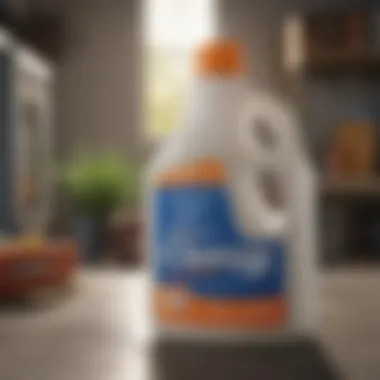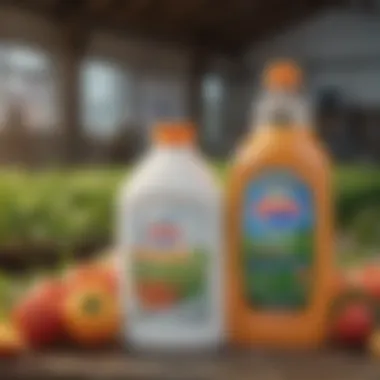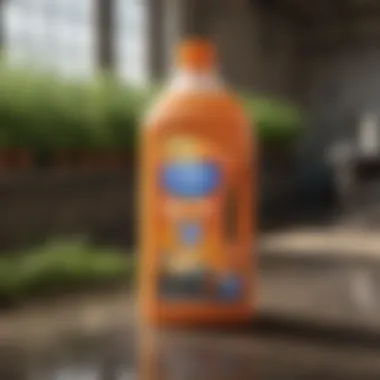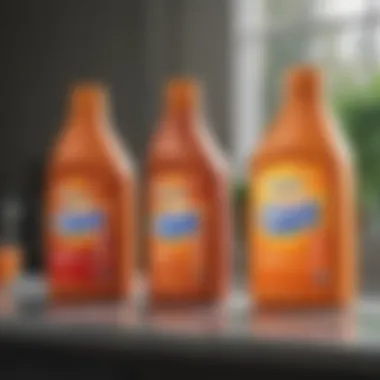Clorox vs Clorox 2: Key Differences Explained


Intro
The world of cleaning products can be quite challenging for consumers. The multitude of brands and options may lead to confusion, especially when it comes to products that share similar names and branding. Clorox and Clorox 2 are two products that often experience this brand-induced complexity. While both products are associated with the Clorox brand, they serve different purposes and have distinct formulations. This article aims to clarify these differences, providing an informative guide for consumers looking to optimize their laundry routines.
Understanding the nuances between Clorox and Clorox 2 can greatly impact a consumer's cleaning practices. With an informed choice, individuals can ensure that their laundry is not just clean but also maintained in good condition. This leads to fewer fabric damages and improved garment longevity.
Key Concepts and Terminology
Basic Definitions
Clorox is well-known as a bleach product that is effective in eliminating stains and disinfecting surfaces. It is primarily used for white fabrics but can also be applied to other surfaces in the household for sanitation purposes. Its active ingredient is sodium hypochlorite, which acts powerfully against bacteria and viruses.
Clorox 2, on the other hand, is often marketed as an oxygen bleach alternative. Its formulation includes hydrogen peroxide and is designed for use on colorfast fabrics. This product aims to brighten colors and remove stains without the harsh effects associated with traditional bleach. Awareness of these definitions is essential for making informed choices in cleaning.
Historical Context
The Clorox brand emerged in the early 20th century, specifically in 1913, primarily known for its bleach products. Over the years, Clorox expanded its portfolio to accommodate varying consumer needs. Clorox 2 was introduced as a gentler option, catering to concerns about using chlorine bleach on colored fabrics. This enriched the brand's reputation, establishing it as a versatile choice for both tough stains and gentler laundry applications.
Through the evolution of these products, Clorox has maintained a focus on quality and effectiveness. Understanding the historical context helps consumers appreciate how these products have developed and adapted to meet modern laundering demands.
Prelude to Clorox and Clorox
In today’s household cleaning landscape, Clorox and Clorox 2 often stand out as two prominent laundry products. Though their similar names may create confusion, understanding their distinct purposes and characteristics is crucial for effective cleaning. This section aims to inform consumers about these products, enabling better-informed decisions for their laundry needs.
Background of the Brands
Clorox has established itself as a trusted name in cleaning solutions since the early 1900s. Originally known for its bleach products, Clorox has expanded its range to include various disinfectants and cleaning agents. Clorox 2 was introduced later, aimed specifically at stain removal and brightening fabrics. It offers a different formulation that caters to the needs of consumers looking to maintain the vibrancy of their clothing.
Both brands carry the reputation of reliability and effectiveness in stain removal and disinfection, shaping the way households approach cleaning tasks.
Purpose of the Comparison
The primary goal of comparing Clorox and Clorox 2 is to clarify their unique attributes. Despite being part of the same family, their formulations serve different functions. Clorox is known for its disinfecting properties, while Clorox 2 aims to enhance the brightness and remove stains from fabrics. A clear understanding of their intended purposes allows consumers to choose the right product tailored to their specific cleaning tasks. In an era where many products are available for cleaning and maintenance, making the appropriate choice based on knowledge can lead to not only effective cleaning but also better fabric care.
Clorox: An Overview
Clorox is a well-known cleaning product, primarily recognized for its versatility in stain removal and disinfecting capabilities. Understanding Clorox is critical for consumers who seek effective solutions for their cleaning needs. As a product, Clorox has established itself as a household staple, particularly in managing spills and stains that often occur in daily life.
Its formulation and specific uses are important to consider, especially in a context where many consumers might not know the exact advantages it offers over its counterparts.
Chemical Composition
The active ingredient in Clorox is sodium hypochlorite, which functions as a bleach and disinfectant. This chemical compound accounts for Clorox's ability to remove tough stains and eliminate bacteria, viruses, and molds. The concentration of sodium hypochlorite typically ranges between 5% to 6%. In addition to the active ingredient, Clorox includes other components that aid in cleaning. These additives can act as stabilizers, surfactants, or other agents that help improve effectiveness. Understanding this composition is vital, especially for users focused on safety and proper usage.
Intended Uses


Clorox is versatile in its application. It is commonly used in households for laundry purposes, particularly for white fabrics. Its effectiveness extends beyond laundry; it's frequently utilized to disinfect surfaces in kitchens and bathrooms. The product's strong nature makes it suitable for tough jobs but may not be necessary for light cleaning tasks. Clorox is not recommended for every type of fabric, as it can cause discoloration or damage. Knowing when and how to use Clorox properly can maximize its benefits.
Effectiveness in Stain Removal
Clorox excels in removing a variety of stains, including those from coffee, wine, and grass. The bleaching action helps lift dark stains, making it particularly advantageous in laundry. In tests, Clorox has shown an ability to outperform many other cleaning agents for specific stain categories. However, its effectiveness can depend on several factors such as the type of fabric and nature of the stain. It is essential for users to recognize its strengths while also being mindful of its limitations, especially regarding colored fabrics.
"Understanding the unique characteristics of a cleaning product is essential for maximizing its potential and safety in any household."
Clorox is a powerful tool, yet it requires responsible usage to achieve the best outcomes without compromising fabric integrity or safety. Being well-informed about its options enables consumers to select the most appropriate cleaning method.
Clorox 2: An Overview
Clorox 2 serves as a relevant counterpart to Clorox when discussing laundry products, yet it holds distinct characteristics that merit examination. It is essential to understand how Clorox 2 differs from its predecessor, Clorox, in formulation and intended use. This section helps demystify Clorox 2, illuminating its role in enhancing laundry cleaning experiences.
Chemical Composition
Clorox 2 is formulated differently compared to standard Clorox. While Clorox primarily contains sodium hypochlorite, Clorox 2 utilizes a blend of non-chlorine bleach. The primary active ingredients in Clorox 2 are generally based on hydrogen peroxide and other proprietary compounds, designed to be gentler on fabrics. This composition allows it to effectively brighten colors and remove stains without the harshness often associated with chlorine bleach products.
The absence of chlorine makes Clorox 2 a safer option for colored fabrics, reducing the risk of fading or damage. Understanding this difference is critical for consumers who want to preserve the integrity of their laundry while still achieving cleanliness.
Intended Uses
Clorox 2 is specifically marketed for use with colored clothes. Its formulation is designed to be a color-safe alternative to traditional bleach. Many users rely on Clorox 2 for its ability to whiten whites while simultaneously maintaining the vibrancy of colored fabrics. It can be used in both regular wash cycles and as a pre-treatment for tougher stains.
Moreover, Clorox 2 complements the cleaning power of standard detergents. It enhances their effectiveness without overwhelming the fabrics’ original colors. For households filled with diverse laundry, Clorox 2 provides a practical solution, as it can safely coexist with various fabric types.
Effectiveness in Stain Removal
Clorox 2 demonstrates strong capabilities in stain removal, particularly for organic stains such as food or beverages. Its oxygen-based formulation activates upon contact with water, releasing active oxygen that penetrates and lifts stains without damaging the material.
While it performs admirably on many stains, its effectiveness may vary depending on the stain type and fabric composition.
"Clorox 2 is an excellent choice if you need a gentle yet effective stain removal solution for colored fabrics."
Its stain-specific performance contributes to its appeal, providing users with a versatile laundry aid that meets a variety of cleaning needs. Knowing Clorox 2's strengths can guide consumers towards making effective choices in their laundry routines.
Key Differences Between Clorox and Clorox
The comparison of Clorox and Clorox 2 is vital for consumers who seek effective solutions for their laundry needs. The distinctions between these two products extend beyond branding, revealing unique formulations and specific applications. Understanding these differences empowers users to select the right product, ensuring optimal performance and safety in their cleaning routines. This section lays out critical aspects of how Clorox and Clorox 2 differ, highlighting their roles in stain removal and fabric care.
Formulation Differences
The core of the difference between Clorox and Clorox 2 lies in their formulations. Clorox, which primarily contains sodium hypochlorite, serves as a traditional bleach. It is effective in killing bacteria and viruses, making it suitable for sanitizing surfaces and whites. However, this strong composition can lead to fabric damage if not used correctly.
On the other hand, Clorox 2 is formulated with a blend of color-safe bleach and other cleansing agents. This makes Clorox 2 suited for colors and delicate fabrics, minimizing the risk of fading or fabric breakdown. Its formulation is focused on enhancing color brightness and removing stains while preserving the integrity of the fabric. Thus, choosing between the two depends on the type of cleaning task, with Clorox favored for sanitation, and Clorox 2 preferred for laundry with colors.


Usage Recommendations
Understanding how to use each product correctly is essential for achieving the best cleaning results. Clorox is often recommended for use in laundry loads that contain whites or heavily soiled fabric. To ensure safety, users should always dilute Clorox before application, especially in washing machines. The typical recommendation advises adding 1 cup of Clorox to the wash cycle when the machine is filled with water.
Clorox 2, conversely, is suitable for all colorfast fabrics. It can be added to either the wash cycle or as a pre-soak for stubborn stains. Generally, it is recommended to use 1 cup of Clorox 2 for every medium-sized load. This versatility allows users to mix colors without fear of bleed or damage, which is particularly appealing for those with mixed laundry.
Stain-Specific Performance
Different stains require tailored approaches for removal, which is where the performance of these products shines. Clorox is more adept at tackling organic stains like blood, sweat, and food; it effectively breaks down these tough marks. However, users must exercise caution as using Clorox on colored fabrics can permanently alter the color.
In contrast, Clorox 2 excels with stains from everyday activities, such as grass, dirt, and mud. Its formulation works gently on colored fabrics while maintaining their vibrancy. That said, it might not have the same efficacy against tougher organic stains as Clorox. Hence, identifying the type of stain is significant in determining which product to employ.
"Understanding these differences helps consumers make informed choices that align with their needs and fabric types."
In summary, the distinctions between Clorox and Clorox 2 greatly influence their use. Knowing the formulation differences, proper usage recommendations, and stain-specific performances can lead to smarter cleaning decisions, enhancing overall laundry experiences.
Safety Considerations
Understanding safety considerations is essential in evaluating household cleaning products like Clorox and Clorox 2. Each product has its own set of safety protocols and recommendations that consumers should adhere to. By knowing these guidelines, users can minimize risks associated with contact, inhalation, and potential allergic reactions. This section outlines important safety aspects related to these products.
Toxicity and Precautions
Clorox contains sodium hypochlorite, a powerful chemical known for its disinfecting properties. However, it also poses certain toxicity risks if not handled properly. Exposure to this compound can lead to respiratory issues and skin irritation. It is crucial for users to follow the instructions provided on the label, including proper dilution measures and usage frequencies. Always store Clorox away from children and pets and ensure the area is well-ventilated during use.
On the other hand, Clorox 2, formulated for color-safe stain removal, presents fewer risks concerning toxicity. However, it still contains active ingredients that can irritate skin or eyes. Protective measures such as wearing gloves and goggles are advisable when handling this product. Consumers should always read and abide by label directions to mitigate the chances of accidents.
Moreover, it is essential to avoid mixing Clorox with other cleaning agents, especially ammonia. This combination can create harmful gases that may pose immediate health threats. Always ensure safekeeping of products in their original containers to prevent confusion and unintentional misuse.
Impact on Fabrics
The choice between Clorox and Clorox 2 can significantly affect the integrity of your fabrics. Clorox is an effective bleach that may damage colored fabrics, leading to fading or discoloration. It is designed primarily for whites and can weaken fabric fibers over repeated use. Because of its high strength, it is essential to use Clorox sparingly on delicate items.
In contrast, Clorox 2 is geared towards maintaining color while effectively removing stains. Users can utilize it on a wider variety of fabrics without the fear of bleaching. This makes it a preferred option for individuals who want their laundry to remain vibrant while still achieving cleanliness. However, it's important to conduct a patch test on a hidden area of the fabric before using any cleaning agent extensively.
In summary, the safety considerations for Clorox and Clorox 2 are paramount. Understanding the toxicity levels, required precautions, and impacts on various fabrics is essential for safe and effective usage. By adhering to safety guidelines and ensuring proper usage, consumers can maximize the benefits of these cleaning products while minimizing risks.
Environmental Impact
The environmental impact of household cleaning products like Clorox and Clorox 2 cannot be overlooked. As consumers become more conscious about their ecological footprint, understanding how these products affect the environment is crucial. Both effectiveness and environmental safety often influence purchasing decisions. Therefore, knowing how these products are formulated and their subsequent consequences is important for responsible use.
Biodegradability
Biodegradability is a key factor in assessing the environmental footprint of cleaning products. Clorox is designed primarily for disinfection, while Clorox 2 is formulated for stain removal. Both products contain various active ingredients that may break down over time but not all components are environmentally friendly.
Clorox products often contain bleach, which can have long-lasting effects if it enters waterways. This bleach does not fully degrade and can cause harm to aquatic ecosystems. In comparison, Clorox 2 contains enzymes and surfactants that are typically more biodegradable than chlorine-based components. Enzymes can break down organic materials effectively, which can mitigate environmental impact.


It’s essential to check product labels for information regarding biodegradability. This practice helps consumers make informed choices that prioritize ecological responsibility.
Presence of Harmful Chemicals
The presence of harmful chemicals in cleaning products raises significant concerns for both human health and the environment. Clorox, which includes bleach, is known for its excellent disinfectant properties but can release harmful fumes upon use. This exposure can lead to respiratory issues when inhaled.
In contrast, Clorox 2 avoids harsh chemicals; however, it does contain substances that may still pose risks. Certain surfactants and preservatives, while effective for stain removal, can potentially harm aquatic life when washed down the drain.
Before using any product, it is beneficial to research the ingredients thoroughly. Awareness about harmful chemicals can guide users in making choices that protect not only their health but also the ecology.
Staying informed about both biodegradability and the presence of harmful chemicals in household cleaning products empowers consumers to minimize their environmental impact.
Consumer Preferences
The examination of consumer preferences plays a crucial role in the discussion of Clorox and Clorox 2. Consumers have become more discerning over the years, often seeking products that align with their specific needs for cleaning and stain removal. This section underscores the importance of understanding consumer behavior and preferences surrounding these products.
When consumers choose between Clorox and Clorox 2, factors such as effectiveness, safety, and environmental impact often guide their decisions. Being aware of these preferences helps brands tailor their marketing strategies and product formulations to better meet the expectations of their customers. Additionally, understanding how consumers perceive the value of each product in their unique cleaning tasks is essential for companies to remain competitive in the household cleaning market.
Potential buyers often consider product reviews, recommendations from friends, and their previous experiences. All these elements cumulatively affect the purchasing decision. Furthermore, the shift towards more sustainable and eco-friendly cleaning options is increasingly influencing consumer preferences today. This shift highlights the need for brands to innovate and adapt their products in ways that align with today’s consumer values.
"Consumer preferences are not merely reflections of trends; they are vital indicators for brands to understand market demands."
Market Research Findings
Market research reveals significant insights into consumer behavior. Surveys indicate that a large percentage of users prefer Clorox for its broad applications in disinfecting and general cleaning. Clorox is often viewed as a go-to solution for tough stains and bacteria. In contrast, Clorox 2 attracts consumers looking for a product specifically designed for color-safe stain removal without the harsh effects of traditional bleach.
Key findings from studies show:
- Familiarity: Most users are familiar with Clorox as the leading bleach brand, contributing to its longstanding trust in the market.
- Satisfaction Rates: Product satisfaction rates indicate that Clorox 2 users often report a positive experience with color retention and stain-fighting effectiveness.
- Target Demographics: Younger consumers tend to lean towards Clorox 2 due to its perceived gentler formulation and an emphasis on safety in laundry applications.
Moreover, online platforms like Reddit have discussions around user experiences, providing invaluable qualitative data regarding preferences and product performance. This modern open feedback loop empowers consumers and influences future purchasing decisions.
User Experiences and Recommendations
User experiences are vital in shaping the landscape of consumer preferences. Many customers gravitate towards products that meet their expectations in cleaning efficacy and safety. Experiences shared across platforms, including Facebook and Reddit, have highlighted various uses of both Clorox and Clorox 2, reinforcing their brand identities.
Here are common user recommendations:
- For Tough Stains: Many recommend using Clorox for dealing with robust stains or disinfecting surfaces due to its high chlorine content.
- For Color Fabrics: Users suggest choosing Clorox 2 when working with colored fabrics, as it is less aggressive on materials while still providing effective stain removal.
- Versatility: Some users point out that Clorox products have versatile applications beyond laundry, being effective for surface cleaning and sanitizing as well.
A review analysis shows that consumers appreciate transparent labeling and straightforward usage instructions. They recommend that brands emphasize their product’s features clearly in order to support informed decisions. These shared experiences contribute to the evolving narratives surrounding Clorox and Clorox 2, positioning these products in the eyes of consumers within a context of practicality and reliability.
Epilogue
In the realm of household cleaning, distinguishing between Clorox and Clorox 2 is critical for consumers aiming to achieve effective results. Understanding the key differences in their formulations, intended uses, and stain removal capabilities allows individuals to make informed decisions tailored to their specific cleaning needs. Each product serves a unique purpose; thus, clarifying these distinctions is essential for maximizing effectiveness while minimizing potential damage to fabrics and other surfaces.
Summary of Key Points
- Chemical Composition: Clorox contains sodium hypochlorite, mainly targeting disinfectant purposes, while Clorox 2 is formulated with color-safe bleach designed for stain removal without harming colors.
- Intended Uses: Clorox is ideal for disinfection and whitening whites, while Clorox 2 focuses on brightening and caring for colored fabrics.
- Effectiveness in Stain Removal: Clorox is potent on tough stains but may discolor colored items, whereas Clorox 2 effectively targets stains while preserving color integrity.
- Safety Considerations: Both products require careful handling, but the risk of fabric damage is a significant factor when choosing between them.
- Environmental Impact: Its critical to evaluate biodegradability and harmful chemical presence in both products, as environmental considerations become more paramount to consumers.
- Consumer Preferences: Gathering user experiences highlights the preferences and recommendations that can guide new users in their choice between these two products.
Final Thoughts
Choosing the right cleaning product can deeply influence not only the effectiveness of laundry but also the longevity of your fabrics. The nuanced differences between Clorox and Clorox 2 should not be overlooked. Careful consideration of their unique properties will enable you to optimize stain removal and care for your garments. With environmental impact and safety at the forefront of consumer consciousness today, deciding which product aligns with your values is as important as its practical effectiveness. Understanding these aspects ultimately serves to educate and empower consumers in the cleaning product marketplace.















